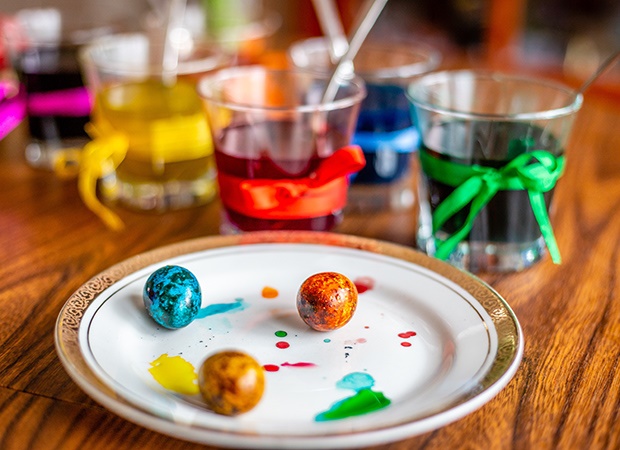Tips for hard-boiling eggs
1. If you’re painting eggs you want to peel and eat later, check if they’re off before you paint them. Old eggs will float in water.
2. To hard-boil multiple eggs at the same time, bake them in the oven in a muffin tray instead of boiling in a pot – 30 minutes at 180 ? will do the trick.
3. If you want to create slightly bouncy eggs, peel the hard-boiled egg then submerge it in vinegar overnight. The outside of the egg will be slightly bouncy. Proceed to colour with edible food dyes.
ALSO TRY: Homemade marshmallow eggs
Tips before painting eggs
1. Keep your egg cartons and turn them upside down to stabilise hard-boiled eggs while painting them.
2. To easily “blow out” an egg, shake the egg in your hand first to “scramble” the contents, then make a hole with a needle on one end. Enlarge it slightly with a skewer. Next, shake the egg out over a glass like you would an empty ketchup bottle. The shaken-up egg should just run out.
3. A blown-out egg can be more easily painted if you stick a skewer through it. Then rest the skewer ends over a plastic container to catch the drips of paint.
Tips for colouring eggs
1. White eggs show colour far more vividly than brown eggs. You can lighten a brown egg by leaving it in a vinegar solution for several hours. The shell will lighten slightly and be more porous to colour. However, if you’re looking for white eggs to start out with, Farmer Angus eggs are ideal. And they’re organic!
2. You can make natural dye for your Easter eggs from food or spices boiled in hot water. Strain after 40 minutes of simmering, then transfer into a glass just tall enough to submerge the egg. Add a teaspoon of vinegar to each natural dye solution. Leave the egg in the colour overnight.
– Turmeric creates bright yellow.
– Cabbage creates purple and, with bicarb added, a deep blue.
– Onion skins create brown/orange.
– Beetroot creates a deep pink dye.
3. Use a whisk to submerge an egg into a food colouring solution. The egg can be popped through the wire slats and lifted out easily after.
4. If you place them on a counter to dry, they may stick. Use a cookie-drying tray instead.
Tips if you’re looking for quick creative results
Note: Make sure your egg is hard-boiled or use a blown-out egg shell.
1. Use office stickers for a neat polka dot effect all over your Easter egg.
2. Try using painter’s tape to tape a pattern on the egg before dipping it into a food colouring solution. If you want a checkered pattern, tape stripes in perpendicular directions, dip it in one colour dye, then remove only one direction of stripes and dip it in another colour of dye.
3. For a criss-cross nest effect, instead of using string that slides off, use rubber bands in overlapping different directions. Dip it into colouring and, when dry, remove the bands.
4. Spray shaving cream into a glass oven dish. Drip two different colours of food colouring in various spots. With a skewer, create a marble pattern in the foam. Then submerge the eggs in the foam for 30 minutes. You’ll be left with a mottled, marbled effect.
Here’s wishing you a healthy, safe and creative Easter indoors!
ALSO READ: 7 Wondrous ways to add pizzazz to your hot cross buns this year

